International Journal of Modern Education and Computer Science @ijmecs
Статьи журнала - International Journal of Modern Education and Computer Science
Все статьи: 1123
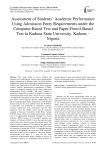
Статья научная
The study aimed to assess whether the students from mathematical science-based undergraduate degree programmes in Kaduna State University perform academically better when either the Computer-Based Test (CBT) or the Paper-Pencil Test (PPT) is used to write the Unified Tertiary Matriculation Examination (UTME), which is conducted annually by the Joint Admissions Matriculation Board (JAMB). The study adopted a quantitative approach to research. A purposive sample of one thousand and twenty-three (1023) first-year students constituted the population for the study. This population was drawn from Computer Science, Mathematics and Physics undergraduate degree programmes in the Kaduna State University who were admitted from the 2010/2011 to 2012/2013 and 2015/2016 to 2016/2017 academic sessions respectively. The instruments used for data collection were the UTME scores and the academic standing of first-year Cumulative Grade Point Average (CGPA) results, which were coded and analysed with the aid of Computational Statistical Package for Social Sciences (SPSS) version 23. Descriptive statistics and Analysis of Variance (ANOVA) were the statistical tools used to answer the four (4) research questions raised. The results revealed a majority of the students who performed academically better were those who used the PPT as their test medium in writing the UTME. It concluded that the majority of the students who wrote the UTME using PPT performed better in their academics. The study thereby recommended that there is a need for the Joint Admissions Matriculation Board (JAMB) to review its examination policies in mathematics-based subjects to enable students to pass such subjects with flying colours, thereby encouraging them to perform better academically in the undergraduate studies.
Бесплатно
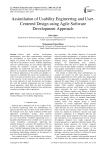
Статья научная
Various agile software development methodologies, since their commencement, encouraged the development of high quality software product. Quality of a product is the compelling trait that plays a vital role in any product's success. Usability engineering and User centered design are user-centered approaches, covering the customer's concerns. The way these approaches are understood and carried out with agile practices is not properly understood and adopted till now. For software applications to be usable and valuable it is necessary to understand the correct user requirements in order to develop the interface that is usable and valuable to the customer. In this research work, we are discussing the scrum approach of agile development and integrate this with the usability engineering and user centered design approaches which helps the agile development team to understand usability demand of users and develop a product according to their expectations.
Бесплатно
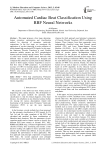
Automated Cardiac Beat Classification Using RBF Neural Networks
Статья научная
This paper proposes a four stage, denoising, feature extraction, optimization and classification method for detection of premature ventricular contractions. In the first stage, we investigate the application of wavelet denoising in noise reduction of multi-channel high resolution ECG signals. In this stage, the Stationary Wavelet Transform is used. Feature extraction module extracts ten ECG morphological features and one timing interval feature. Then a number of radial basis function (RBF) neural networks with different value of spread parameter are designed and compared their ability for classification of three different classes of ECG signals. Genetic Algorithm is used to find best value of RBF parameters. A classification accuracy of 100% for training dataset and 95.66% for testing dataset and an overall accuracy of detection of 95.83% were achieved over seven files from the MIT/BIH arrhythmia database.
Бесплатно
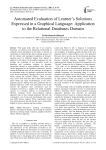
Статья научная
This paper deals with one of our research directions on software tools enhancing self-learning in computer science disciplines. In this study, we discuss an experiment on relational data bases learning using a tool for the edition and automated evaluation of learners’ solutions given as relational algebra trees. Indeed, in addition to the interest of the graphic languages for any training, the evaluation of our precedent works on modeling and evaluating solutions as algebraic expressions showed us some problems: first, there are various languages for the algebraic expressions. Second, among the detected errors by the prototype, developed in our precedent works for algebraic expressions, the form errors about the algebraic language have to be corrected before starting the semantic analysis. Third, in some cases, errors in the form have led to other non-committed errors which can cause inconsistencies in the errors’ diagnosis process. Starting from these problems, the two principal objectives of the work presented in this article concern the algebraic trees construction and the evaluation assisted by a graphic tool which essentially consists in a semantic analysis as recommended in ODALA (ontology driven auto-evaluation learning approach) that we have already proposed. The tool was evaluated by a set of tests and experimented with second year LMD license students. These experiments results were interesting and showed that the tool is particularly helpful for novice students and their teachers.
Бесплатно
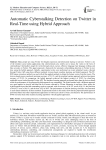
Automatic Cyberstalking Detection on Twitter in Real-Time using Hybrid Approach
Статья научная
Many people are using Twitter for thought expression and information sharing in real-time. Twitter is one of the trendiest social media applications that cybercriminals also widely use to harass the victim in the form of cyberstalking. Cyberstalkers target the victim through sexism, racism, offensive language, hate language, trolling, and fake accounts on Twitter. This paper proposed a framework for automatic cyberstalking detection on Twitter in real-time using the hybrid approach. Initially, experimental works were performed on recent unlabeled tweets collected through Twitter API using three different methods: lexicon-based, machine learning, and hybrid approach. The TF-IDF feature extraction method was used with all the applied methods to obtain the feature vectors from the tweets. The lexicon-based process produced maximum accuracy of 91.1%, and the machine learning approach achieved maximum accuracy of 92.4%. In comparison, the hybrid approach achieved the highest accuracy of 95.8% for classifying unlabeled tweets fetched through Twitter API. The machine learning approach performed better than the lexicon-based, while the performance of the proposed hybrid approach was outstanding. The hybrid method with a different approach was again applied to classify and label the live tweets collected by Twitter Streaming in real-time. Once again, the hybrid approach provided the outstanding result as expected, with an accuracy of 94.2%, recall of 94.1%, the precision of 94.6%, f-score of 94.1%, and the best AUC of 98%. The performance of machine learning classifiers was measured in each dataset labeled by all three methods. Experimental results in this study show that the proposed hybrid approach performed better than other implemented approaches in both recent and live tweets classification. The performance of SVM was better than other machine learning algorithms with all applied approaches.
Бесплатно
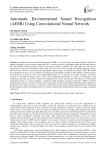
Automatic Environmental Sound Recognition (AESR) Using Convolutional Neural Network
Статья научная
Automatic Environmental Sound Recognition (AESR) is an essential topic in modern research in the field of pattern recognition. We can convert a short audio file of a sound event into a spectrogram image and feed that image to the Convolutional Neural Network (CNN) for processing. Features generated from that image are used for the classification of various environmental sound events such as sea waves, fire cracking, dog barking, lightning, raining, and many more. We have used the log-mel spectrogram auditory feature for training our six-layer stack CNN model. We evaluated the accuracy of our model for classifying the environmental sounds in three publicly available datasets and achieved an accuracy of 92.9% in the urbansound8k dataset, 91.7% accuracy in the ESC-10 dataset, and 65.8% accuracy in the ESC-50 dataset. These results show remarkable improvement in precise environmental sound recognition using only stack CNN compared to multiple previous works, and also show the efficiency of the log-mel spectrogram feature in sound recognition compared to Mel Frequency Cepstral Coefficients (MFCC), Wavelet Transformation, and raw waveform. We have also experimented with the newly published Rectified Adam (RAdam) as the optimizer. Our study also shows a comparative analysis between the Adaptive Learning Rate Optimizer (Adam) and RAdam optimizer used in training the model to correctly classifying the environmental sounds from image recognition architecture.
Бесплатно
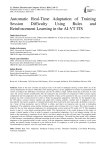
Статья научная
Some of the most common and typical issues in the field of intelligent tutoring systems (ITS) are (i) the correct identification of learners’ difficulties in the learning process, (ii) the adaptation of content or presentation of the system according to the difficulties encountered, and (iii) the ability to adapt without initial data (cold-start). In some cases, the system tolerates modifications after the realization and assessment of competences. Other systems require complicated real-time adaptation since only a limited number of data can be captured. In that case, it must be analyzed properly and with a certain precision in order to obtain the appropriate adaptations. Generally, for the adaptation step, the ITS gathers common learners together and adapts their training similarly. Another type of adaptation is more personalized, but requires acquired or estimated information about each learner (previous grades, probability of success, etc.). Some of these parameters may be difficult to obtain, and others are imprecise and can lead to misleading adaptations. The adaptation using machine learning requires prior training with a lot of data. This article presents a model for the real time automatic adaptation of a predetermined session inside an ITS called AI-VT. This adaptation process is part of a case-based reasoning global model. The characteristics of the model proposed in this paper (i) require a limited number of data in order to generate a personalized adaptation, (ii) do not require training, (iii) are based on the correlation to complexity levels, and (iv) are able to adapt even at the cold-start stage. The proposed model is presented with two different configurations, deterministic and stochastic. The model has been tested with a database of 1000 learners, corresponding to different knowledge levels in three different scenarios. The results show the dynamic adaptation of the proposed model in both versions, with the adaptations obtained helping the system to evolve more rapidly and identify learner weaknesses in the different levels of complexity as well as the generation of pertinent recommendations in specific cases for each learner capacity.
Бесплатно
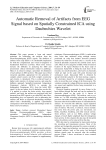
Статья научная
This paper presents a boon and amend technique for eradicating the artifacts from the Electroencephalogram (EEG) signals. The abolition of artifacts from scalp EEGs is of considerable implication for both the computerized and visual investigation of fundamental brainwave activities. These noise sources increase the difficulty in analyzing the EEG and procurement clinical information related to pathology. Hence it is critical to design a procedure for diminution of such artifacts in EEG archives. This paper uses a blind extraction algorithm, appropriate for the generality of complex-valued sources and both complex noncircular and circular, is introduced. This is achieved based on higher order statistics of dormant sources, and using the de?ation approach Spatially-Constrained Independent Component Analysis (SCICA) to separate the Independent Components (ICs) from the initial EEG signal. As the next phase, level-4 daubechies wavelet db-4 is applied to extract the brain activity from purged artifacts, and lastly the artifacts are projected back and detracted from EEG signals to get clean EEG data. Here, thresholding plays an imperative role in delineating the artifacts and hence an improved thresholding technique called Otsu’s thresholding is applied. Experimental consequences show that the proposed technique results in better removal of artifacts.
Бесплатно
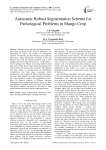
Automatic Robust Segmentation Scheme for Pathological Problems in Mango Crop
Статья научная
Machine vision and soft computing techniques have been promising in the field of agriculture and horticulture to remove the barriers of conventional methods for detecting the plant diseases using different plant parts. Image segmentation technique is first and primary step in all the related researches such as fruit grading, leaf lesion region detection etc. In this paper, a robust technique for Mango crop using different plant parts such as Fruit, Flower and Leaf has been proposed in order to detect the disease more accurately. The captured real time images are pre-processed for illumination normalization and color space conversion before segmentation. The standard K-Means clustering scheme has been made adaptive and edge detection transforms have been applied to improve the segmentation results. Here, the objective function of K-Means clustering technique has been modified and cluster centers also have been updated to segment the diseased parts from images. The results obtained are better in the terms of both general human observation and in computational time.
Бесплатно
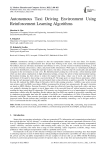
Autonomous Taxi Driving Environment Using Reinforcement Learning Algorithms
Статья научная
Autonomous driving is predicted to alter the transportation industry in the near future. For decades, carmakers, researchers, and administrators have already been working in this sector, with tremendous development. Nevertheless, there are still many uncertainties and obstacles to solve, not only in terms of technical technology, as well as in terms of human consciousness, culture, and present traffic infrastructure. With respect to technological challenges, precise route identification, avoiding the improper location, time delay, erroneous drop-off, unsafe path, and automated navigation in the environment are only a few. RL (Reinforcement Learning) has evolved into a robust learning model which can learn about complications in high dimensional settings, owing to the advent of deep representation learning. Environment learning has been shown to reduce the required time delay, reduce cost of travel, and improve the performance of the agent by discovering a successful drop-off. The major goal is to ensure that an autonomous vehicle driving can reach passengers, pick them up, and transport them to drop-off points as quickly as possible. For performing this task, RL methods like DQNs (Deep Q Networks), Q-LNs (Q-Learning networks) , SARSAs (state action reward state actions), and ConvDQNs (convolution DQNs) are proposed for driving Taxis autonomously. RL agent’s decisions are based on MDPs (Markov Decision Processes). The agent has effectively learnt the closest path, safety, and lower cost, gradually obtaining the capacity to travel bigger areas of the successful drop-off without negative incentive for reaching the target using these RL approaches. This scenario was chosen based on a set of requirements for simulating autonomous vehicles using RL algorithms. Results indicate that ConvDQNs are capable of successfully controlling cars in simulation environments than other RL methods. ConvDQNs are a combinations of CNNs (Convolution Neural Networks) and DQNs. These networks show better results than other methods as their combining of procedures gives improved results. Results indicate that ConvDQNs are capable of successfully controlling a car to navigate around a Taxi-v2 environment than the existing RL methods.
Бесплатно
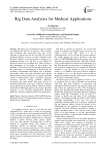
Big data analytics for medical applications
Статья научная
Big Data is an accumulation of data sets which are abundant and intricate in character. They comprise both structured and unstructured data that evolve abundant, so speedy they are not convenient by classical relational database systems or current analytical tools. Big Data Analytics is not linearly able to expand. It is a predefined schema. Now big data is very helpful for backup of data not for everything else. There is always a data introducing. It also helps to solve India’s big problems. It also helps to fill the data gap. Health care is the conservation or advancement of health along the avoidance, interpretation and medical care of disorder, bad health, abuse, and other substantial and spiritual deterioration in mortal. Health care is expressed by health experts in united health experts, specialists, physician associates, mid-wife, nursing, antibiotic, pharmacy, psychology and other health. This paper focuses on providing information in the area of big data analytics and its application in medical domain. Further it includes introduction, Challenging aspects and concerns, Big Data Analytics in use, Technical Specification, Research application, Industry application and Future applications.
Бесплатно
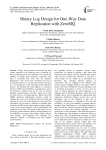
Binary log design for one-way data replication with ZeroMQ
Статья научная
Today, many business transactions are done online, especially in the financial sector or banking [1]. But as companies grow, many problems occur such as the inability to manage data consistency, especially when data is associated with more than one database. Replication is one of the most commonly used way of syncing data. However, to ensure data remains consistent, it is not enough just to take advantage of the replication process. The problem that often happens is connection failure or offline host. The Binary Log approach is one of the alternative methods that can be used to develop database synchronization. Generally, binary log is used for data recovery or backup purposes. Binary log in the DBMS (Database Management System) record all changes that occur in the database both at the data and structure level, as well as the duration of time used. This information can be used as a reference in updating data, while the ZeroMQ socket used as data exchange medium so data in all system locations will be synchronized and integrated in real time. This research will discuss how to develop a synchronization system by utilizing Binary Log from MySQL to recognize data changes, inherit changes, send changes, and hopefully can contribute new alternative method in developing real time database synchronization.
Бесплатно
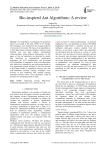
Bio-inspired Ant Algorithms: A review
Статья научная
Ant Algorithms are techniques for optimizing which were coined in the early 1990’s by M. Dorigo. The techniques were inspired by the foraging behavior of real ants in the nature. The focus of ant algorithms is to find approximate optimized problem solutions using artificial ants and their indirect decentralized communications using synthetic pheromones. In this paper, at first ant algorithms are described in details, then transforms to computational optimization techniques: the ACO metaheuristics and developed ACO algorithms. A comparative study of ant algorithms also carried out, followed by past and present trends in AAs applications. Future prospect in AAs also covered in this paper. Finally a comparison between AAs with well-established machine learning techniques were focused, so that combining with machine learning techniques hybrid, robust, novel algorithms could be produces for outstanding result in future.
Бесплатно
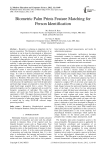
Biometric Palm Prints Feature Matching for Person Identification
Статья научная
Biometrics is playing an important role for person recognition. The Biometrics identification of an individual is can be done by physiological or behavioral characteristics; where the palm print of an individual can be captured by using sensors and is one of among physiological characteristics of an individual. Palm print is a unique and reliable biometric characteristic with high usability. A palm print refers to an image acquired of the palm region of the hand. The biometric use of palm prints uses ridge patterns to identify an individual. Palm print recognition system is most promising to recognize an individual based on statistical properties of palm print image. It is rich in its features: principal lines, wrinkles, ridges, singular points and minutiae points. This paper proposes a Biometric Palm print lines extraction using image processing morphological operation. The proposed work discusses the significance; since both the palm print and hand shape images are proposed to extract from the single hand image acquired from a sensor. The basic statistical properties can be computed and are useful for biometric recognition of individual. This result and analysis will result into Total Success Rate (TSR) of experiment is 100%. This paper discusses proposed work for biometric recognition of individual by using basic statistical properties of palm print image. The experiment is carried out by using MATLAB software image processing toolbox.
Бесплатно
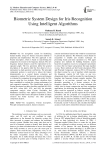
Biometric system design for iris recognition using intelligent algorithms
Статья научная
An iris recognition system for identifying human identity using two feature extraction methods is proposed and implemented. The first approach is the Fourier descriptors, which is based on transforming the uniqueness iris texture to the frequency domain. The new frequency domain features could be represented in iris-signature graph. The low spectrums define the general description of iris pattern while the fine detail of iris is represented as high spectrum coefficients. The principle component analysis is used here to reduce the feature dimensionality as a second feature extraction and comparative method. The biometric system performance is evaluated by comparing the recognition results for fifty persons using the two methods. Three classifiers have been considered to evaluate the system performance for each approach separately. The classification results for Fourier descriptors on three classifiers satisfied 86% 94%, and 96%, versus 80%, 92%, and 94% for principle component analysis when Cosine, Euclidean, and Manhattan classifiers were applied respectively. These results approve that Fourier descriptors method as feature extractor has better accuracy rate than principle component analysis.
Бесплатно
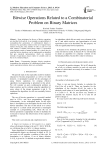
Bitwise Operations Related to a Combinatorial Problem on Binary Matrices
Статья научная
Some techniques for the use of bitwise operations are described in the article. As an example, an open problem of isomorphism-free generations of combinatorial objects is discussed. An equivalence relation on the set of square binary matrices having the same number of units in each row and each column is defined. Each binary matrix is represented using ordered n-tuples of natural numbers. It is shown how by using the bitwise operations can be implemented an algorithm that gets canonical representatives which are extremal elements of equivalence classes relative to a double order on the set of considered objects.
Бесплатно
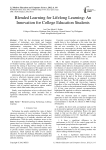
Blended Learning for Lifelong Learning: An Innovation for College Education Students
Статья научная
With the fast developing and changing transport of technology, new trends and learning opportunities were ushered in the field of Education. This transformation restructures the teaching-learning operation. As a result, educators encounter different learning preferences of students due to the emerging learning needs brought by technology. Although many universities here and abroad recognize the potential of blended learning, there is still lack of implementation on how blended learning be planned, designed and applied. In response to this need, an empirical study on the use of blended learning approach was conducted, which involved the mixing of face-to-face and online delivery methods. Thus, the main purpose of this paper was to find out the effect of blended learning (BL) approach on the students' performance in education subjects. Additionally, this work presents instructional strategies on how to effectively integrate content, pedagogy and technology to enhance the teaching and learning of education courses. This provided the most effective and efficient learning experiences on both teachers and learners with its practical applications against retailed software which often burden many universities. Finally, some implications on how to effectively blend pedagogy and technology, which inevitably lead to significant enhancement of the curriculum, were also discussed.
Бесплатно
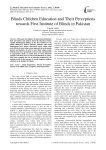
Blinds Children Education and Their Perceptions towards First Institute of Blinds in Pakistan
Статья научная
This paper investigates the parental participation,their perceptions and opinions about the education of their visually handicapped children in the first institute for the blinds children in Multan Pakistan. Students with visual impairments have unique educational needs which could most effectively meet using a team approach of professionals,parents and students. In order to meet their unique needs,students must have specialized services, books and materials in appropriate media to enable them to most effectively compete with their peers in school and ultimately in society.This study examines the role of education imparted by the institute as felt by the parents of visually impaired children admitted at the institute for blinds.
Бесплатно
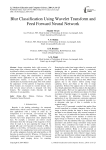
Blur Classification Using Wavelet Transform and Feed Forward Neural Network
Статья научная
Image restoration deals with recovery of a sharp image from a blurred version. This approach can be defined as blind or non-blind based on the availability of blur parameters for deconvolution. In case of blind restoration of image, blur classification is extremely desirable before application of any blur parameters identification scheme. A novel approach for blur classification is presented in the paper. This work utilizes the appearance of blur patterns in frequency domain. These features are extracted in wavelet domain and a feed forward neural network is designed with these features. The simulation results illustrate the high efficiency of our algorithm.
Бесплатно
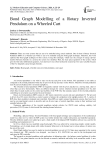
Bond Graph Modelling of a Rotary Inverted Pendulum on a Wheeled Cart
Статья научная
There are some systems that are yet to be modelled using certain methods. One of them is Rotary Inverted Pendulum (RIP) on a wheeled cart which is yet to be modeled using the bond graph technique. Therefore, this work explored the bond graph technique for this system. Using this technique, which uses the concept of energy (power) transfer between elements in a system, the system was modeled. Then, the state space equations of the system, which give the first-order differential equations, were derived. It was observed that the system has five state variables because of the five integrally causal storage elements.
Бесплатно

